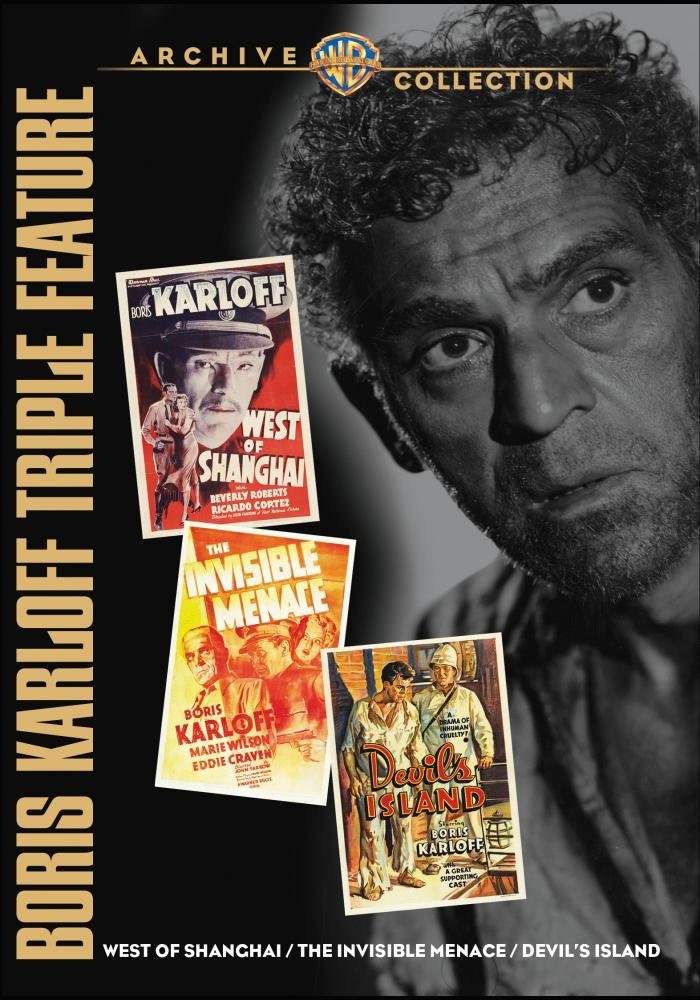
Written by Kristen Lopez
Warner Archive continues to put out intriguing DVD collections meant to entice die-hard fans. Their latest, the Boris Karloff Triple Feature, is a three-disc set that might shock casual Karloff fans because he isn’t playing a horror icon. Yes, Karloff does wear heavy make-up in one (although it’s not exactly PC), but the collection is meant to emphasize the range the legend had, but didn’t always get the chance to show. The movies are short, but the lack of bonus material and overall quality of the films themselves might turn off casual viewers. Thankfully, the Warner Archive creates these sets purely for the genuine movie lover, so if you consider Karloff your favorite, I recommend picking up the collection.
What movies are contained within? In the adventure picture West of Shanghai (1937), Karloff plays General Fang, a violent Chinese warlord who holds a group of American missionaries’ hostage, but discovers his inner humanity when he discovers a hostage once saved his life. The Invisible Menace (1938) is a murder mystery involving Karloff’s Mr. Jevries, spies, and a smuggled bride. And Devil’s Island (1939) has Karloff as a treasonous, idealistic doctor sent to a French penal colony where he discovers the horrors within.
All three movies are about an hour or less (Invisible Menace is only 55 minutes), so you can easily whip the entire collection out in less than three hours. The brevity helps with some of the less enjoyable movies, especially The Invisible Menace. Unfortunately, the short length does lead to a lot of the audience having to put the pieces together. The intricacies of the plot in West of Shanghai don’t feel nearly as developed as it would if the movie were 90 minutes. I felt as if a lot had happened that I either missed, or was simply excised. Thankfully, out of the three movies I recommend seeing two, which makes the collection worth buying.
West of Shanghai is an interesting slice of what sold in 1930s cinemas. Due to the popularity of China, dozens of movies emphasizing the “mysticism of the Orient” were produced. West of Shanghai is an intriguing one that not only highlights the racial differences between whites and Asians, but the class differences inherent within Caucasians themselves. It could be hindsight now, but I felt more for General Fang than I did for any of the white characters! The opening scene has Gordon Creed (Ricardo Cortez) telling the ticket-taker of the train that he refuses to ride in second class because “I’m not used to sitting in second.” Later on, the character of Lola Galt (Sheila Bromley) hopes that her dinner doesn’t take too long to cook because the Asian General riding the train might “go on a sit-down strike.” I’m not quite sure how 1930s audiences responded to lines like that, but today you just feel these are ignorant jerks that deserve what they get. Karloff and Bromley are certainly good in their respective roles. Bromley is a sassy, Barbara Stanwyck-type who easily stands up to General Fang. I actually wished the rest of the players had been removed and it was just her. The way it plays out, she seems to be set dressing for a large portion of the movie. Karloff is closely aligned with his Frankenstein-esque character as he spends the movie in “Asian-face.” It’s offensive to be sure, but he doesn’t play it like a Charlie Chan character. He tones it down and makes the character work. By the end, the movie isn’t quite sure if it wants Fang to be the villain or not. He does find his humanity, but it feels a bit saccharine. I’d recommend giving it a watch (I’ve seen worse Asian stereotyping, and this one actually explores the differences during that period).
The worst of the bunch is The Invisible Menace. This is a staid murder mystery that has weird moments of levity and one annoying female character. I couldn’t engage myself in this one because of actress Marie Wilson who plays the smuggled bride Sally Wilson Pratt. She’s hoping to be a Jean Harlow character, but has the voice of Lina Lamont from Singin’ in the Rain. I wasn’t entirely sure why she was present, aside from preventing this from being an all-male cast. Karloff is good as the wrongly accused man, but he played the role far better in Devil’s Island. This is a cursory watch for all Karloff completists, but one of the least watchable in the group.
Karloff’s best out of trio is 1939’s Devil’s Island. It’s in the vein of I Am a Prisoner from a Chain Gain, or Andersonville, although less on the atrocities. The script is tightly wound, the story is intriguing, and there’s some inspired shot choices; especially the one where the rod for the leg irons is pulled in and out throughout the day. The movie does fall into sickeningly sweet territory once the warden’s wife vows to save Karloff’s character, but the movie expertly uses its 64 minute runtime to full effect. Karloff is as normal as it gets in this role; free of makeup or fake hair. He humanizes Dr. Gaudet. He’s not a monster or a saint; he’s just a man. It’s by far the best-rounded role for him in this group. The only bonus feature for the movie is the trailer for this.
Overall, it’s up to the audience to decide whether two good movies, out of three, are worth the purchase. Warner Archive gives a fascinating look into an actor known only for looking unrecognizable. With Devil’s Island, especially, you come to know Karloff as a talented actor who was more than a man swathed in prosthetics. I recommend picking it up if you’re interested in seeing Karloff do other things, or are a staunch fan of his.